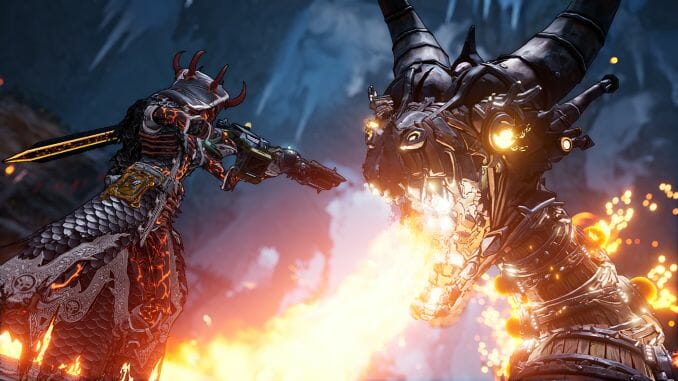Shoot Your Way Through a Tabletop RPG Session with Tiny Tina’s Wonderlands

Tiny Tina’s Wonderlands is an intriguing convergence of RPG systems and shooting mechanics in a delightful world with mostly pleasant characters, though whether it accurately reflects tabletop roleplaying will be up for each player to decide. It’s a fun game, but mileage will vary depending on individual tolerance for the Borderlands house style, from aesthetic to sense of humor (though it veers more cuddly and less edgy this time around) and level scaling. While it’s by no means polemic, it’s got a point of view that will keep it from being forgettable, while mostly trending positive with a narrative about overcoming trauma and loneliness.
Having just come off a year-and-a-half first-timers Dungeons & Dragons campaign, I found myself frequently comparing my real-world table-top RPG experiences with those of my player character. The premise of the game is that Borderlands series regular Tiny Tina (the prolific Ashly Burch) oversees a game of Bunkers & Badasses with newcomers captain Valentine (Andy Samberg) and the robot Frette (Wanda Sykes), as the player (“Newbie”) joins the party while the Dragon Lord (Will Arnett) interlopes.
The Bunkers & Badasses game board serves as an overworld through which players are connected to the various settings and landmarks, but also where players can discover quests unique to overworld mechanics and get into encounters in the tall grass or avoid those encounters by smacking away foes with the melee button. The bobblehead representative of the player character and NPCs as well as that melee encounter-counter contribute to a humorous tone that feels somewhat adolescent, but is mostly more accessible rather than obnoxious. While I didn’t fall out laughing too frequently, I chuckled or smirked more than I rolled my eyes. The variety of available quests—easily compiled on your way through Mount Craw seeking a bard to bless your boat, or in Tangle Drift exploring the consequences of a magic beanstalk—gives the player access to all sorts of storytelling. While sometimes it can be unsophisticated, Tiny Tina’s Wonderlands is much more Fable than South Park, and sometimes, like in the quest “Twenty Thousand Years Under the Sea,” it’s surprisingly emotionally effective, if not altogether shocking.
On the topic of access, there are three difficulty settings, as well as options for things like aim assist, snap-to-target, and the ability to change reticle colors, as well as toggles and size settings for closed captions and subtitles. What is confoundingly lacking is general text size settings. If you’ve got, say, a 32” TV and you have less-than-perfect vision, it might be hard to make out some tutorial instructions or menu and inventory text, especially on horizontal split-screen. This seems like a wild oversight in a game that is clearly attempting to be inclusive.
That drive for inclusion extends to the wealth of character customization options, such as personal pronouns (which default to they/them) as well as makeup options (as producer Kayla Belmore alluded to in her interview with Paste earlier this year) and pitch modulation for six voice styles. The character body types aren’t even gendered, referred to instead as “this one” and “that one.” There’s a good variety in human skin tones, as well as fantasy tones and textures. Hair styles could be a little more fleshed-out, specifically kinkier hair textures—Tiny Tina’s Wonderlands is decidedly worse than Cyberpunk 2077 and somehow better than Elden Ring when it comes to Black hair. Much as in real life, I’m content with dreadlocks, but more ambitious players won’t be recreating Jon Batiste or Lil Nas X in Tiny Tina’s Wonderlands. At least an effort was made here; it’s merely found lacking. Nevertheless, players unlock additional aesthetic customization options as loot as they go throughout the game and can completely recreate their character’s appearance at any time by returning to the hub city.
Tiny Tina’s Wonderlands is gorgeous to look at—a captivating combination of vibrant colors and cell-shading that’s fun to shoot through, climb over, or explore in photo mode. Gearbox Software have come a long way since the original Borderlands helped popularize looter-shooters, and the premise of this game allows for castles to burst out of thin air and geography to be remade according to the narrator’s design. That isn’t completely random or player-propelled, but it looks nice anyway. Moreover, it’s a fun and diverse world to explore. The Wonderlands comes from taking simple concepts like skeleton pirates or a giant beanstalk and twisting them to reiterate references or spin into totally new directions.
-

-

-

-

-

-

-

-

-

-

-

-

-

-

-

-

-

-

-

-

-

-

-

-

-

-

-

-

-

-

-

-

-

-

-

-

-

-

-

-








































